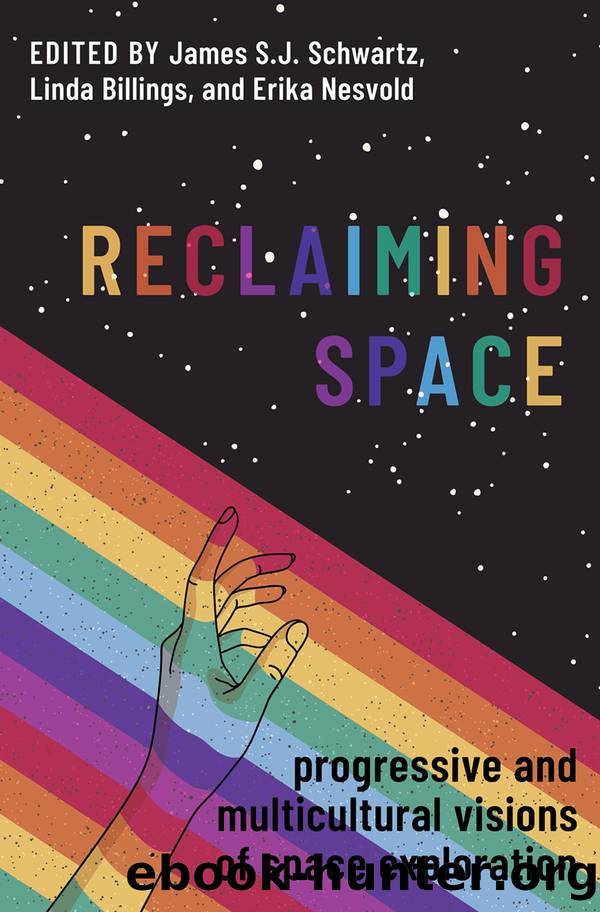Reclaiming Space by Schwartz James S. J.;Billings Linda;Nesvold Erika;

Author:Schwartz, James S. J.;Billings, Linda;Nesvold, Erika;
Language: eng
Format: epub
Publisher: Oxford University Press, Incorporated
Published: 2022-03-15T00:00:00+00:00
Why Ethics Is Like the Three-Body Problem
Let us work with an imperfect analogy and imagine for a moment that space ethics is like celestial mechanics, the science that deals with the motion of the planets. Of course, ethics is not a science, but it is not this aspect of the analogy that interests me. Rather, I am concerned with the broad similarity of science and ethics as techniques for problem solving. Like celestial mechanics, ethics deals with a certain class of problems and tries to find solutions. If we press the analogy a little further, we can ask whether ethics is like a two-body problem or a three-body problem. In the case of two-body problems, we can easily track what is going on by positing a stable center, a dynamic point around which two planets or celestial bodies move in their different ways. When we add a third body, things become chaotic. Readers may be familiar with this idea from an important work of science fiction by the Chinese author Cixin Liu (2015), who uses the three-body problem as a metaphor for a clash of civilizations. In Cixin Liuâs novel, The Three-Body Problem, the inhabitants of Earth and a group of invaders from elsewhere settle down to an uneasy compromise. They find a balance point around which both can work, one that allows both to calculate risks and opportunities. But everything collapses once a third civilization enters into the picture. It only takes one more body to throw all the calculations off.
An actual three-body problem is like this, as well. If we want a clear solution to it, then we have to start restricting the conditions by assuming that one or more of the bodies has no motion or else that it has negligible mass. In other words, we have to introduce some fairly artificial assumptions. Unless this is done, the required calculations will never end. They will be nonfinite. The simplicity of working around an easily identified, shared, and stable center will be lost.
Pursuing this analogy, I want to suggest that ethics is more like a three-body problem rather than a two-body problem. Yet, when faced with uncontrollable complexity, we are continually tempted to restrict matters in ways that will artificially yield a decision procedure for each and every question. We want ethics to have a kind of determinacy about everything. A determinacy that is a poor fit for how the world is, and for what we are. We want a stable center. Or many of us do, for much of the time. Disagreements then ensue about exactly where this center should be placed. The disagreements can take the form of disputes about which cluster of concepts should be sovereign: those connected to rights, consequences, or virtue. Concepts which all have important roles to play. Or disagreements can take the form of disputes about the kind of âcentrismâ that is most appropriate. Anthropocentrism (Passmore 1974) presupposes a human center. Biocentrism (Taylor 1986) presupposes that the flourishing of the biological or of biotic communities should be the measure of all things.
Download
This site does not store any files on its server. We only index and link to content provided by other sites. Please contact the content providers to delete copyright contents if any and email us, we'll remove relevant links or contents immediately.
| Coloring Books for Grown-Ups | Humor |
| Movies | Performing Arts |
| Pop Culture | Puzzles & Games |
| Radio | Sheet Music & Scores |
| Television | Trivia & Fun Facts |
Paper Towns by Green John(4771)
Spare by Prince Harry The Duke of Sussex(4762)
Machine Learning at Scale with H2O by Gregory Keys | David Whiting(3518)
Never by Ken Follett(3500)
Learning C# by Developing Games with Unity 2021 by Harrison Ferrone(3273)
Fantastic Beasts and Where to Find Them: Illustrated edition by J.K. Rowling & Newt Scamander(2904)
Fairy Tale by Stephen King(2898)
The Man Who Died Twice by Richard Osman(2788)
Reminders of Him: A Novel by Colleen Hoover(2701)
How The Mind Works by Steven Pinker(2601)
0041152001443424520 .pdf by Unknown(2578)
Will by Will Smith(2555)
Fantastic Beasts and Where to Find Them: The Original Screenplay by J. K. Rowling(2401)
The God delusion by Richard Dawkins(2167)
Rationality by Steven Pinker(2137)
Borders by unknow(2103)
Never Lie: An addictive psychological thriller by Freida McFadden(2028)
The Dawn of Everything: A New History of Humanity by David Graeber & David Wengrow(1997)
Friends, Lovers, and the Big Terrible Thing by Matthew Perry(1969)
